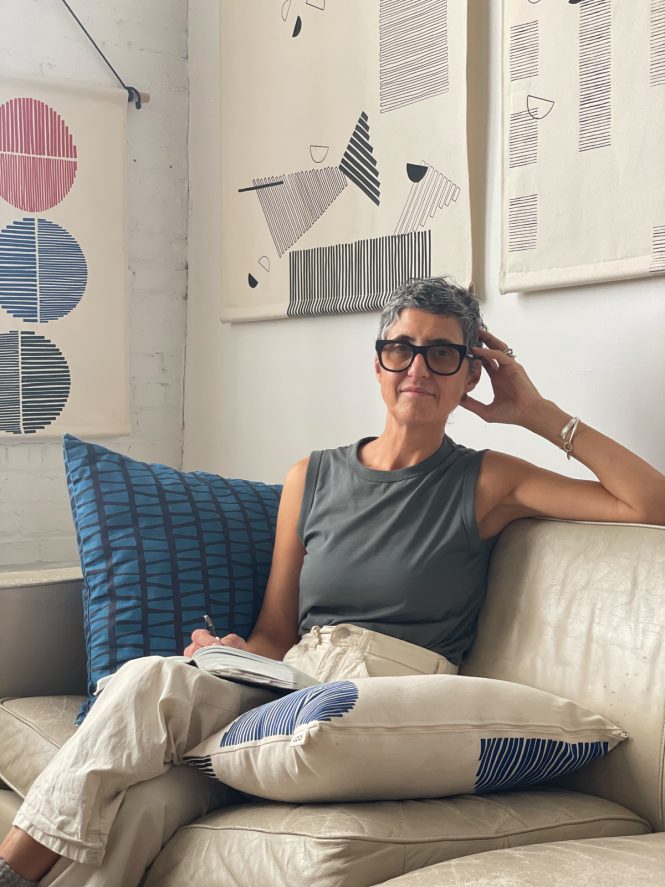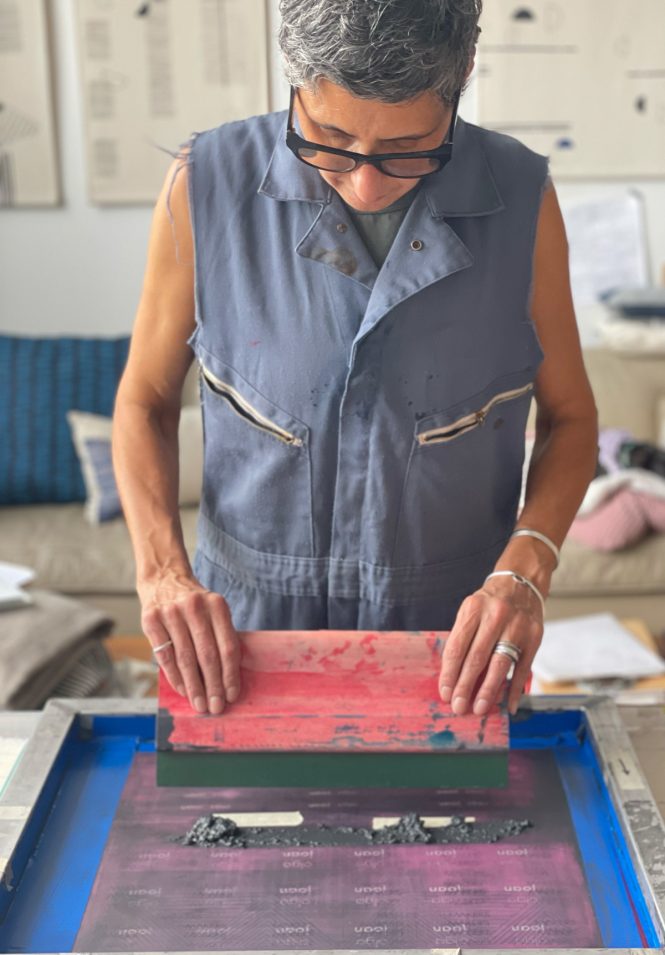A Change of Style: Kingston-Based Textile Maker Olga Joan
By Naomi Shammash | Winter 2023 | Makers
After more than 20 years working in fashion and apparel, Olga Joan was fed up. Her initial love of her job had given way to frustration with the industry’s standards, including the heavy workload borne by designers, the lack of consideration for the environment, and the dearth of creativity. Joan, now 56, had built a career considered successful by many metrics—jobs with brands like Levi’s and Abercrombie & Fitch, financial stability, and then some—but found herself disheartened and burnt out. So she left the Gap, where she’d been working for nine years, and founded an eponymous home goods business in 2016. Olga Joan makes functional, modern products that feature simple lines, geometric forms, and a neutral color palette. The brand’s offerings, which range from aprons to couch cushions to napkins, are all handmade in Joan’s studio in Kingston.
“I made a huge, huge decision,” Joan says of starting her business, which has since been included in HGTV magazine, the holiday gift guide of the New York Times, and Architectural Digest. She had her husband, two college-age children, and a mortgage to consider, not to mention the daunting task of turning her back on the career she’d spent the past few decades constructing. Upon leaving the Gap, she took six months off to recharge, during which she stopped looking at anything remotely fashion-oriented and started asking herself what she was going to do. In an effort to learn new skills, she took a screen printing class at the Textile Arts Center in Brooklyn, and knew that she wanted to make the discipline the basis of her work going forward. That and her previous experience with fabrics, color, and pattern, as well as her love of interior design, led her to what she calls “a natural progression” into home goods.

In her Kingston studio, Olga Joan makes functional home goods from handprinted linens that feature simple lines, geometric forms, and a neutral color palette.
Joan’s personal aesthetic, consisting of geometric patterns, shapes, and hand-drawn linear artwork, is the driving force of the Olga Joan brand. She’s inspired by both Scandinavian and Japanese design traditions, loving the “minimalist clean modernness” of the former and the latter’s “indigo, simplicity, and idea that things might not always look perfect.” The Japanese aesthetic tradition of wabi-sabi, the acceptance of imperfection, grants Joan the confidence to make mistakes as she moves through the design process. She refuses the label of artist—“I can’t draw for anything,” she admits—but many of her designs start as doodles in little notebooks and a gut feeling. The first one she implemented was the zig-zag that she’s come to be known for, a pattern that makes an appearance on almost every product and in the Olga Joan logo. It’s triangular, made of thin lines stacked closely on top of one another, and is often printed in the bright reds and deep saturated blues that are mainstays in the brand’s color palette. Her human touch is visible in the drawing; the lines vary in thickness and the spaces between them aren’t standardized. When looking at the pattern on the whole, however, the shapes flow with regularity. Joan’s designs are at once orderly enough to please the eye and disorderly enough to be intimately human.
Before launching her company, Joan had a clear set of values for the brand in mind, many of which were in direct opposition to what she’d seen in the fashion world. “I wanted to be far away from fast fashion,” she says, and “use fabrications as sustainable to the environment as I possibly could find.” She sources fabrics close to home to avoid overseas shipping, though she makes exceptions for premier quality that helps create a practical, long-lasting product, such as European linen and, occasionally, Japanese denim. She believes in the importance of local production: Joan screen prints, cuts, and sews all her products, sometimes hiring an assistant in the area to help with shipping. Though she’s not American—she grew up in Scotland before moving to New York—she thinks that “we should be producing our goods in the States and bringing that kind of economy to our community.”

Olga Joan handprints all the labels for her products in her Kingston studio.
Joan currently works out of the Shirt Factory in Midtown Kingston, but hopes to open a hybrid storefront-makerspace where customers can see the screen printing process in the near future. In the meantime, she plans on more collaborations with interior designers and custom products; she’s been making one-of-a-kind wall hangings and designing aprons for local chefs and stylists. “Doing special pieces for folks, I really love,” she says. “That’s what I strive to do.”
